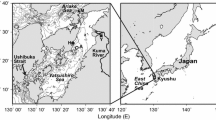Abstract
IN attempting cultures of pelagic diatoms it is the common experience that success is more often achieved when the isolating procedures have not been so thorough as to eliminate all bacteria from the cultures. Although direct nutritional dependence on excretions of the bacteria cannot always be ruled out, physico-chemical effects are probably of greater importance. But do bacteria play the same part in nature? The onset of the spring increase of phytoplankton in coastal waters can seldom be traced to simple causes. It is often observed to follow a period of quiet fine weather when a major factor is undoubtedly the absence of vertical mixing. Light may be all that is needed to trigger the diatom growth; but it is also conceivable that the winter water requires “conditioning” before growth can start, and the slight increase of temperature at the surface during a fine spell increases bacterial metabolism sufficiently for this. Such an effect will be greatest when the association between bacteria and diatoms is most intimate—that is, between any epiphytic bacteria and their host cells. It is not clear from the literature, however, how close is the association between bacteria and phytoplankton in the sea. Marine bacteria are nearly always associated with particulate matter1,2, and there is often a correlation between the abundance of bacteria and living diatoms2,3. Nevertheless, live plankton diatoms do not seem to harbour a heavy epiphytic flora, as do many freshwater algae. On the contrary, the cells usually appear to be remarkably clean. There are, however, no published observations, although other evidence4,5 suggests that diatoms may have antibiotic activity.
Similar content being viewed by others
References
Lloyd, B., J. Mar. Biol. Assoc., U.K., 16, 879 (1930).
Waksman, S. A., Kreuszer, H. W., Carey, C. L., Hotchkiss, M., and Renn, C. E., Biol. Bull., Woods Hole, 64, 183 (1933).
Gran, H. H., Biol. Bull., Woods Hole, 64, 159 (1933).
Steeman Nielsen, E., Deep Sea Res., Suppl., 3, 281 (1955).
Sieburth, J. McN., and Pratt, D. M., Trans. N.Y. Acad. Sci., Ser. II, 24, 498 (1962).
Provasoli, L., McLaughlin, J. J. A., and Droop, M. R., Arch. Mikrobiol., 25, 392 (1957).
Author information
Authors and Affiliations
Rights and permissions
About this article
Cite this article
DROOP, M., ELSON, K. Are Pelagic Diatoms Free from Bacteria?. Nature 211, 1096–1097 (1966). https://doi.org/10.1038/2111096a0
Issue Date:
DOI: https://doi.org/10.1038/2111096a0
- Springer Nature Limited
This article is cited by
-
Enclosure experiment on the control mechanism of planktonic bacterial standing stock
Ecological Research (1992)
-
Sea ice microbial communities. III. Seasonal abundance of microalgae and associated bacteria, Mcmurdo Sound, Antarctica
Microbial Ecology (1984)
-
A membrane adsorption-SEM technique for observing neuston organisms
Microbial Ecology (1983)
-
A distinct temporal separation of maximum bacterial numbers and phytoplankton biomass in the open-water zone of Lake Maarsseveen I: Results and literature review
Hydrobiological Bulletin (1982)





